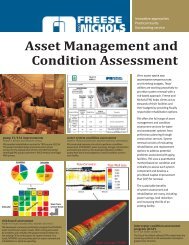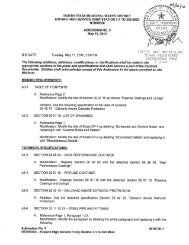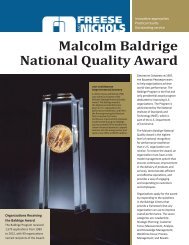final bid specs 09328.pdf - Freese and Nichols, Inc.
final bid specs 09328.pdf - Freese and Nichols, Inc.
final bid specs 09328.pdf - Freese and Nichols, Inc.
You also want an ePaper? Increase the reach of your titles
YUMPU automatically turns print PDFs into web optimized ePapers that Google loves.
sticky under moderate thumb pressure, <strong>and</strong> application of another coat does not<br />
cause undercoat to lift or lose adhesion.<br />
2. If undercoats or other conditions show through <strong>final</strong> coat, apply additional coats until<br />
cured film has a uniform coating finish, color, <strong>and</strong> appearance. Give special attention to<br />
edges, corners, crevices, welds, exposed fasteners, <strong>and</strong> similar surfaces to ensure that<br />
they receive a dry film thickness equivalent to that of flat surfaces.<br />
C. Application Procedures: Apply coatings by brush, roller, spray, or other applicators according<br />
to manufacturer's written instructions.<br />
1. Brush Application: Use brushes best suited for material applied <strong>and</strong> of appropriate size<br />
for the surface or item being coated.<br />
a. Apply primers <strong>and</strong> first coats by brush unless manufacturer's written instructions<br />
permit using roller or mechanical applicators.<br />
b. Brush out <strong>and</strong> work brush coats into surfaces in an even film.<br />
c. Eliminate cloudiness, spotting, holidays, laps, brush marks, runs, sags, ropiness, or<br />
other surface imperfections. Neatly draw glass lines <strong>and</strong> color breaks.<br />
2. Rollers: Use rollers of carpet, velvet back, or high-pile sheep's wool as recommended by<br />
manufacturer for the material <strong>and</strong> texture required.<br />
3. Spray Equipment: Use mechanical methods to apply coating if permitted by manufacturer's<br />
written instructions <strong>and</strong> governing regulations.<br />
a. Use spray equipment with orifice size recommended by manufacturer for material<br />
<strong>and</strong> texture required.<br />
b. Apply each coat to provide the equivalent hiding of brush-applied coats.<br />
c. Do not double back with spray equipment building-up film thickness of two coats in<br />
one pass, unless recommended by manufacturer.<br />
D. Minimum Coating Thickness: Apply each material no thinner than manufacturer's recommended<br />
spreading rate. Provide total dry film thickness of the entire system as recommended<br />
by manufacturer.<br />
E. Prime Coats: Before applying finish coats, apply a prime coat of material, as recommended<br />
by manufacturer, to material required to be coated or finished that has not been prime coated<br />
by others.<br />
1. Recoat primed <strong>and</strong> sealed substrates if there is evidence of suction spots or unsealed<br />
areas in first coat, to ensure a finish coat with no burn-through or other defects caused by<br />
insufficient sealing.<br />
F. Completed Work: Match approved Samples for color, texture, <strong>and</strong> coverage. Remove, refinish,<br />
or recoat work that does not comply with specified requirements.<br />
3.04 FIELD QUALITY CONTROL<br />
A. Owner reserves the right to invoke the following procedure at any time <strong>and</strong> as often as Owner<br />
deems necessary during the period when coatings are being applied:<br />
1. Owner will engage the services of a qualified testing agency to sample coating material<br />
being used. Samples of material delivered to Project site will be taken, identified, sealed,<br />
<strong>and</strong> certified in presence of Contractor.<br />
2. Testing agency will perform appropriate tests for the following characteristics as required<br />
by Owner:<br />
a. Quantitative materials analysis.<br />
b. Absorption.<br />
High-Performance Coatings 09 96 00 - 6<br />
DPR09328












